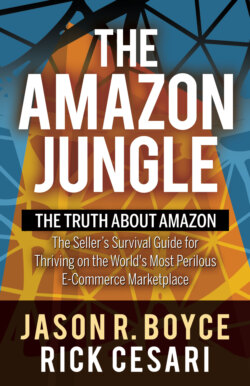Читать книгу The Amazon Jungle - Rick Cesari - Страница 13
На сайте Литреса книга снята с продажи.
IT’S BIGGER THAN YOU THINK
ОглавлениеAmazon is everywhere. It is on a speedy trajectory to become the largest retailer in the United States as it continues to gain on Walmart. Nearly half of the U.S. e-commerce market share already belongs to Amazon, with eBay, once the dominant leader in the field, in a distant second position with just 6.6% of online market share.6
Ironically, in 2019 eMarketer revised this initial 49% market share estimate down to 38% following a vague comment Bezos made in his annual shareholder letter. In it he said that 58% of its e-commerce sales come from Third Party Sellers. This downward revision from such a closely followed researcher highlights a glowing problem. No one really knows how many retail sales go through Amazon.com. Only Amazon knows, and they aren’t sharing that information despite the fact that they are a publicly-traded company. Additionally, DigitalCommerce 360 reported $602 billion in 2019 online sales7 and MarketplacePulse estimated that Amazon’s Gross Merchandise Value was $335 billion.8 If these numbers are accurate, then it is clear that Amazon has increased its market share to 55%, well beyond the 2018 market share estimate. I didn’t buy what eMarketer was selling when they decreased their estimate, but one thing is clear: Amazon wants to appear a lot smaller than they actually are, especially as the trustbusters gather at their gate.
Either way, when you look at Amazon’s reported sales, it’s easy to see how big they are. But consider this: they’re even bigger than what’s being reported. Amazon does not disclose the full retail value of goods sold on its platform, known as the Gross Merchandise Value (GMV) because more than half of its sales come from Third-Party Sellers, for which Amazon must only report the fees it charges them. If I sell a $100 chair on Amazon as a 3P Seller, for example, Amazon will charge me a $15 seller fee for the right to sell my product on their website. While I must report the full $100 GMV to the IRS, Amazon need only report the $15 fee, typically 15% of GMV. With 58% of Amazon sales coming from Third-Party Sellers, the sum value of what’s not being reported by Amazon is staggering. Estimates range in 2020 from $330 billion9 to as high as $530 billion,10 which already makes them larger than Walmart. Just sayin’.
Amazon has been so successful and so dominant that the U.S. and European Union governments may be the only overseers with the power to slow the company’s upward trajectory. Mr. Bezos’s empire has a slew of detractors calling for, among other things, increased taxes on the business and, in the most extreme case, a full-blown breakup. Even if Amazon were to be brought to heel, its competitors would likely still be outrun by the Amazon equivalent of the Baby Bells, a reference to the U.S. regional telephone companies that were formed from the breakup of AT&T (“Ma Bell”) in the mid-1980s. Third-Party Sellers already sell more on Amazon than Amazon sells on its own platform, and a breakup would move Amazon.com from the #1 largest e-commerce website to the #1 and #2 largest e-commerce websites. I know a lot of 3P Sellers who would welcome the thought of not competing against Amazon on their Marketplace, but who knows what might happen if Amazon Retail has its own website and is forced to compete? We’re likely some years away from knowing how the current antitrust inquiries play out, but until then, Amazon will continue devouring the competition; of that, you can be certain.
